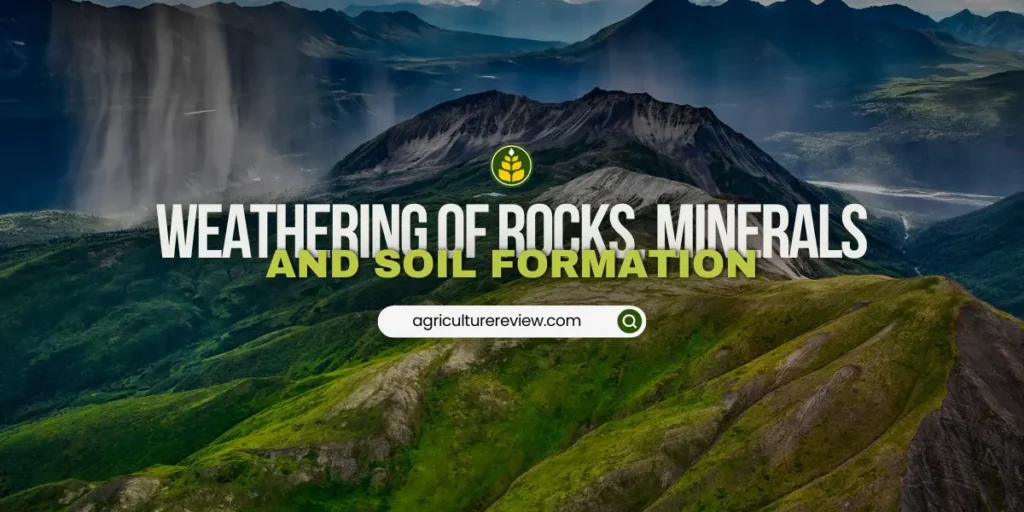Weathering of rocks and minerals are important for the formation of soil. Soils are formed from various types of rocks and minerals through the intermediate stage of regolith. The formation of soil comprises two basic steps that are:
- Formation of regolith by the breakdown of rocks and minerals.
- Decomposition of plant and animal residues and reorganization of these components through soil-forming processes like eluviation and illuviation to form soil material of varying depths.
Table of Contents
What Is Weathering Of Rocks And Minerals?

Weathering of rocks and minerals can be defined as an inevitable natural process of breakdown of rocks and minerals into unconsolidated residues called regolith, lying on the surface of the earth, with varying depths. Weathering does not happen overnight, it is a time-consuming but continuous process that happens over hundreds and thousands of years.
Types Of Weathering Processes
Weathering processes can be classified into three different types:
- Physical Weathering: It is defined as the disintegration of rocks and minerals or as a slow process by which disruption of consolidated massive rocks into smaller bits without any corresponding chemical change or formation of new products.
- Chemcial Weathering: It is defined as the decomposition of the disintegrated rocks and minerals or the transformation of rocks and minerals into new compounds having different chemical composition and physical properties. It is important to note that no chemical weathering takes place without the presence of water.
- Biological Weathering: The action of humans such as cutting rocks, building dams, buildings, roads, and plant roots exerting pressure on rocks, micro-organisms, etc. helps with the physical and chemical breakdown of rocks and minerals and are considered biological weathering.
However, Joffe has stated that. there is no biological weathering, but it is physical and chemical weathering by biological agencies.
Physical Weathering Of Rocks
Physical weathering is a slow process that changes the size of rocks, thus it helps to accelerate the chemical process or reactions by exposing more reacting surfaces as the size of rocks and minerals gets reduced. These are the following factors that play a vital role in the physical weathering of rocks and minerals.
Factors That Cause And Affect Physical Weathering Of Rocks
- Physical Condition Of Rocks: It is the most important factor that determines the rate at which rocks are subjected to weather. For example, coarse-textured porous sandstone will weather more quickly than that of finely textured basalt.
- Temperature: Due to changes in temperature, expansion and contraction in the upper layer of rocks result in the breakdown of bigger-sized rocks.
- Water: It acts as a disintegrating, transporting and depositing agent. Moving water has a tremendous cutting and carrying force. Moreover, water enters rocks and crevices and freezes, thus expanding 9% of its volume which creates a force of about 150 tons per square foot.
- Wind: It causes abrasive action on exposed rocks, the effect is more when wind is laden with sand particles.
- Glaciers: The action of glaciers also helps in physical weathering. The big glaciers start moving due to changes in temperature and slope gradient which exert tremendous pressure on rocks, thus resulting in the breakdown.
- Atmospheric Electrical Phenomenon: During the rainy season, due to frequent lighting rocks break up and wider cracks form.
Chemical Weathering Of Rocks & Minerals
Chemical weathering of rocks is the transformation of rocks and minerals into new compounds having different chemical compositions and physical properties. One of the classical examples of chemical weathering is feldspar, when it is mixed in water, it produces a new substance called clay that has different composition and physical properties.
Note: The chemical reactions increase with dissolved CO2 and other solvents in water and with a rise in temperature. That’s why chemical weathering is low in deserts where water is scarce and in temperate regions due to low temperatures and higher in tropical areas due to the availability of water and high temperatures.
Agents Of Chemical Weathering
The various important agents of chemical weathering of rocks and minerals are as follows:
- Hydrolysis: It involves the splitting of water into H-ions and OH-ions and is the reaction of substances with water to form hydroxides and other new substances. It is a double decomposition process. For example,
Feldspar + Water = Clay mineral + Soluble cations and anions
KAlSi3O8 (Orthoclase) + H2O (Water) = HAlSi3O8 + KOH
2HAlSi3O8 (Recombination) + 8H2O = Al2O3.3H2O (Bauxite) + 6H2SiO3 (Silicic acid)
- Oxidation-Reduction: Oxidation in terms of mineral weathering is a chemical combination of oxygen with a compound as well as the loss of electrons. While in reduction electrons are gained. Oxidation-reduction reaction speeds up mineral breakdown, thus helping in faster decomposition. For example,
4FeO (Ferrous oxide) + O2 = 2Fe2O3 (Ferric oxide)
- Hydration: It is a chemical combination of a solid substance like minerals or salts with water. Hydration changes the mineral structure which increases the volume due to swelling making it softer, thus speeding the process of decomposition. For example,
CaSO4 (Anhydrite) + 2H2O = CaSO4.2H2O (Gypsum)
- Carbonation: It is the combination of Carbon Dioxide with any base. For example,
CO2 + 2KOH = K2CO3 + H2O
Factors Affecting Chemical Weathering Of Minerals
These are the important factors that affect chemical weathering of minerals.
- Climate: Climate affects the rate and kind of weathering. In areas with low rainfall physical weathering occurs rapidly than chemical weathering. However, an increase in moisture content increases physical as well as chemical weathering. The rate of weathering is very fast in humid tropical regions.
- Physical Characteristics: Physical properties of minerals like size, hardness, degree of cementation and composition of rocks influence weathering.
- Chemical and Structural Characteristics: Chemical and structural characteristics such as size, and chemical and crystalline characteristics play a vital role in the ease of decomposition.
Soil Formation
Two processes or phases are involved in the formation of soil,
- The weathering of rocks and minerals.
- The formation of true soil by soil forming factors and pedogenic processes.
Moreover, the first phase which is the weathering of rocks and minerals or disintegration is known as the destructive phase in the formation of soil while the second phase which is the formation of true soil is considered the constructive phase.
Factors Of Soil Formation
Various factors are responsible for the transformation of the parent material into a soil material or a soil profile. Dokuchaiev put forward these factors in the form of an equation.
S = f(cl, o, r, p, t…)
Where, S = Soil formation; f = Function; cl = Climate; o = Organisms; r = Relief; p = Parent Materials; t = Time.
Later on, Jenny emphasized that soil property is determined by the relative influence of all these factors. Jenny considered temperature and rainfall as climate; flora and fauna as biosphere organisms; elevations, slope or topography and depth of water table as relief, and formulated the following equations:
- Active Factors: S = f( cl, b,
- Passive Factors: r, p, t…)
Where, b = Biosphere, others are same as the Dokuchaiev’s equation.
Thus soil forming factors are categorized into two groups that are, i) Active Soil Forming Factors, and ii) Passive Soil Forming Factors.
Active Soil Forming Factors
- Climate: Rainfall, temperature, humidity, aridity and wind influence soil formation directly as well as indirectly. Different climatic conditions determine the different pedogenic processes and help in the formation of different groups of soil like zonal, intrazonal and azonal soils. For example, high temperatures and moderate to high rainfall favor the formation of lateritic soils due to intense weathering and leaching of basic cations.
- Biosphere: The activity of plants and animals and the decomposition of organic wastes and residues by microbes and other small organisms influence soil formation as well as soil profile development.
Passive Soil Forming Factors
- Parent Material: It is the most important factor that determines the soil profile development as well as the physical properties of soils. The less developed a soil is, the greater will be the effect of parent material on the properties of the soil. Moreover, the parent material may be transported from the place of its origin and re-deposited either before it becomes subject to alteration by soil formers during the process of modification, or by organic deposits.
- Relief or Topography: The earth’s surface contour is called topography or relief. It influences the soil formation process through its associated water, temperature, soil erosion and micro-climate relations. For example, in hilly regions, a major portion of rainwater is lost through runoff through which various soluble and insoluble materials are deposited at the base of the slope, thus soils formed on the upper slope are different from the soils formed at the foot or base of hills.
- Time: The period from the zero point of soil development to the present stage is called the age of soil and it is dependent on various factors such as climate, nature of the parent material and topography. Soil age can be determined by carbon dating, pollen analysis or carbonate carbon in Caliche layers.
If you have any queries, ideas or suggestions, then please comment below. You can also connect with Agriculture Review on Facebook, Instagram, Koo and WhatsApp Messenger.





